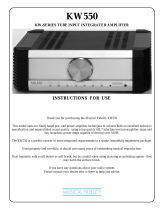5
Note: The unity gain feature must be used with care. It
effectively by-passes the NAC 552 volume and balance
controls leaving any signal connected to a unity gain input
to be passed to the power amplifier and speakers at full
volume. In order to reduce the potential for inadvertent
mishap, any subsequent modifications to input mapping
will automatically disable previously set up unity gain
inputs. Additionally, if an input is selected which has unity
gain enabled, the NAC 552 volume and balance handset
functions will be disabled and their indicators will turn off.
This will be flagged by the volume or balance indicators
flashing if either handset function is operated.
6.6 volume and balance control
The remote handset volume and balance keys provide
some alternative control characteristics. A quick press and
release of a key will adjust by a preset “nudge”. A quick
press and release of a key followed by press and hold will
cause continual slow adjustment. Simple press and hold
will cause continual fast adjustment.
6.7 mute and mono
Mute and mono functions can be controlled independently
for source and record signals via the buttons to the left of
the two banks of source and record selection buttons.
Mute silences the output signal, while mono sums the left
and right channels.
6.8 display
The NAC 552 front panel button display can be switched off
by pressing the remote handset (in preamplifier mode) disp
function. Any subsequent handset or front panel operation
will temporarily restore the display. A second operation of
the disp function will permanently restore the display.
6.9 switch-on
After switch-on, via the NAC 552PS front panel power
button, the NAC 552 will remain muted for 30 seconds
while control systems and circuits stabilise. The source side
will then un-mute automatically leaving the record side
muted (and its circuits unpowered).
6.10 remote control
The Flash remote handset supplied with the NAC 552
duplicates all configuration options. See Section 16 for
more information. The Narcom 3 handset will also control
the NAC 552. See Section 17 for more information.
6.11 defaults
To restore all programmable settings to the factory defaults
press and hold the remote handset disp key while the
preamplifier is in program mode. The preamplifier will exit
from program mode following this operation.
NAC 552
as previously described. The front panel source mono
button will illuminate if automatic switching is already
enabled. If it is not enabled it can be switched on by
pressing the source mono button twice.
With auto switching enabled, pressing the source mono
button will reveal the inputs selected for auto switching
by their button indicators illuminating for a short time.
Repeated operation of the source mono button will
sequentially select through each possible combination of
CD, Tuner, AV inputs, and auto switching disabled (CD,
Tuner and AV button indicators off). When the desired
inputs selected for auto switching are indicated, stop
pressing the source mono button.
The remote handset mono (Flash) or mon (Narcom 3)
key can also be used to set up automatic source
switching. Automatic input switching only becomes
operational on exiting from program mode by pressing
and holding the handset prog key.
Note: In a few cases some further equipment
configuration may be required for auto switching to
operate correctly on the AV input. Please contact your
retailer or local distributor for advice.
6.5 av integration (unity gain)
The NAC 552 unity gain function enables an audio-visual
processor to be integrated such that the processor’s
volume control takes over command of signals
connected to selected NAC 552 inputs. Unity gain can
be selected only on input sockets 4 and 5 (the
corresponding input buttons will depend on the input
mapping set up).
To select unity gain, first switch the NAC 552 into
program mode as previously described. The front panel
source mute button will illuminate if unity gain is
selected on any input. If it is not enabled it can be
switched on by pressing the source mute button twice.
With unity gain enabled, pressing the source mute
button again will reveal the inputs selected by their
button indicators illuminating for a short time. Repeated
operation of the source mute button will sequentially
select each combination of Input 4, Input 5 and unity
gain disabled. When the desired inputs are indicated,
stop pressing the source mute button. The selected
inputs will then be enabled for unity gain. The remote
handset mute key can also be used to set up unity gain.
Unity gain only becomes operational on exiting from
program mode by pressing and holding the handset prog
key.























